Magento, or Adobe Commerce as it is now known, is an open-source CMS platform that specializes in large e-commerce websites. It offers a flexible shopping cart system that allows you to customize the look, content, and functionality of your online store. Catalog management is key to Magento and was central to the update to Magento 2.
It is an incredibly powerful platform, and with that comes some intricacies that can be difficult for some to handle. In most cases, site owners will need some form of developer or engineer support to operate a successful online store on Magento.
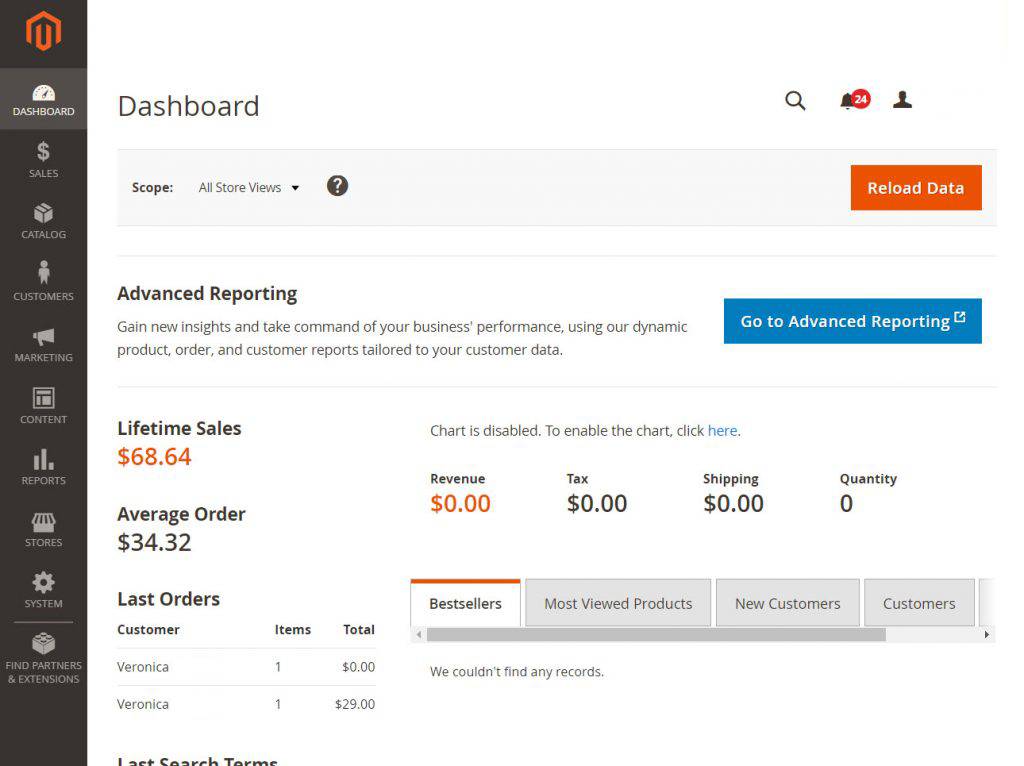
Source: Magento
Although this may seem daunting, we can use plenty of effective strategies and optimizations tailored for Magento to significantly boost SEO performance. In this post, I will help you understand Magento’s strengths and weaknesses, and provide actionable insights to help you overcome specific SEO issues on the platform.
Understanding Magento SEO
As you start to use Magento, you may encounter some challenges as an SEO professional. Let’s look at some of these to better understand what we may come up against.
As you build your website and add more product lines, variations, and inventory changes, URL structures often become increasingly complex. This can present a challenge on all websites, especially with Magento. Adobe Commerce can often create overly complex and lengthy URL strings, which can be challenging to manage if you don’t keep a close eye on the setup.
The length and complexity of URLs can quickly become a problem for organic performance, as they become difficult for users to understand, as well as making them increasingly difficult for search engines to crawl and index correctly.
URLs are just one area that can be problematic, though. The out-of-the-box settings of Adobe Commerce can frequently lead to duplicate content. This duplication commonly comes from creating product variations and pagination setups, meaning that search engines can find it hard to know which page we want to rank.
Unless you use an extension or other third-party tool with Magento (such as Magefan), you may find that your e-commerce site has a number of incorrect or missing canonical tags. Similar to the issue of duplicate content, inadequate canonicals can cause more duplication and mean that some content is incorrectly indexed or, in some cases, not indexed at all.
Working with Magento for a number of years, I’ve seen many of the same issues occur with XML sitemaps. As before, the out-of-the-box settings are quite limited and need a degree of customization to ensure they work correctly and only include indexable URLs with a 200-status code. Using the Amasty tool kit helps to resolve the XML sitemap and other similar issues.
All in all, Magento is an incredibly powerful platform with many levels of customization and controls. As such, it may be hard for beginners to navigate, and the steep learning curve can make it time-consuming and overly complex for some businesses.
What does Magento do well?
I’ve talked a lot so far about the platform’s difficulties, but there are many reasons that make Adobe Commerce the software of choice for so many large-scale and global businesses.
There are plenty of built-in optimizations that are available from the start, including the implementation of meta tags, simple sitemaps, and more, to get a quality store up and running.
Magento allows for effective sales, inventory, and shipping management, making it possible to use the platform for a wide range of business types and industries.
We’ve touched on this briefly, but Magento can seamlessly integrate with a wide range of SEO tools and third-party extensions. This is incredibly useful for advanced optimizations and setup, tracking, and additional store capabilities.
Even if the platform may not do what you need from the start, there will undoubtedly be a workable solution already available online, or you can work with your developers to find a way to make it work for you.
Despite some of the default URLs being long and complicated, the platform makes it straightforward to set up and implement URL rewrites (301 redirects). This is so you can ensure that your URL strings are short, clean, human-readable, and SEO-friendly.
Actionable Magento SEO strategies
Good SEO isn’t just about standard optimizations; we also need to know how to properly use the platforms and technologies that our websites are set up on. We need to know changes and long-term strategies that we can employ to deliver long-term growth.
With that in mind, here are some actionable steps to drive positive SEO performance in Magento.
Optimize Magento category pages
Category pages, or PLPs, are a key component of how an e-commerce website is organized and how well it can be used. They are often one of the most important ways a user can get to the products on a site and, therefore, are a massive factor in performance.
Ensure your categories are structured in a way that makes sense for your customers. Keep them as straightforward as possible, and avoid falling into the trap of creating unnecessary categories that could lead to hundreds of ineffective pages.
Consider the journey you want customers to take to help them convert, and plan your categories accordingly. If you need to make adjustments to the PLPs, use 301 redirects to redirect users to relevant pages instead.
Strong category pages should have multiple internal links to different sub-categories and product pages that are relevant to the current page. To do this, we need to include text content on the page.
This can be either at the top or the bottom of the page, but make sure you discuss the importance and benefits of the category and explain how this category can help the customer.
Ultimately, the best way to optimize your categories in Magento is to create an easy-to-understand layout so that customers can find everything in one place. Magento does this really well by allowing us to set up sub-category listings and expandable menus.
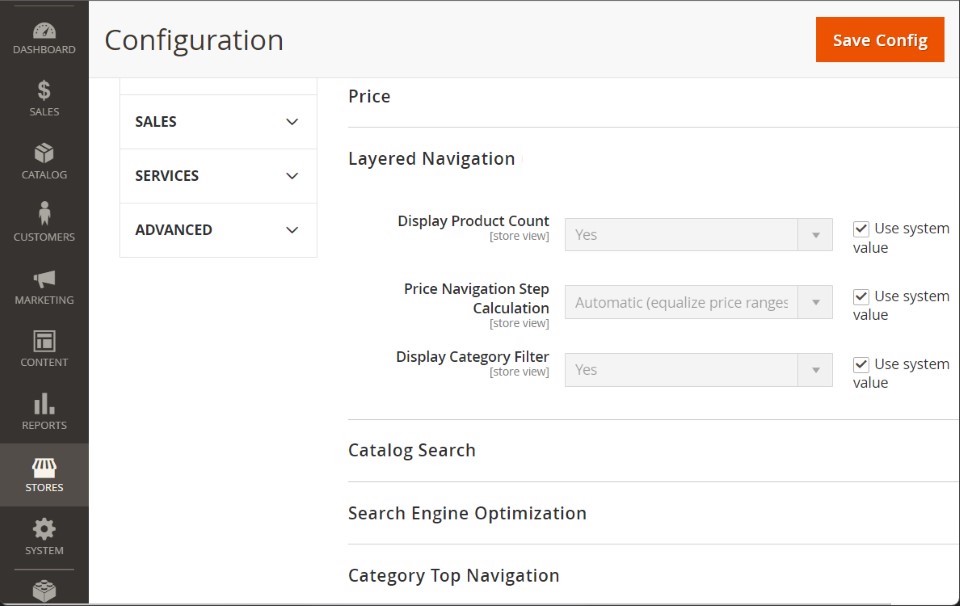
Source: Magento
Optimizing site speed in Magento
Magento is not a slow system, so if you find an issue with your site speed, it is worth checking that your system requirements, hardware, extensions, hosting server, and PHP are all up to date.
If you still see speed issues after ensuring everything is running on the latest version and working as it should, it is worth ensuring that ‘Cache Management’ is enabled and that you have ‘Varnish Cache’ turned on. Magento provides built-in caching types, and turning them on can minimize the number of database operations needed for page requests.
I also suggest configuring your Magento CDN to help your website achieve better speeds.
Magento has a log that can slow down the database backup and your whole store. As site owners, we can optimize the site speed and performance by regularly cleaning these logs, found under the ‘Advanced Configuration’ options and within the ‘Developer’ and then ‘Debug’ menus.
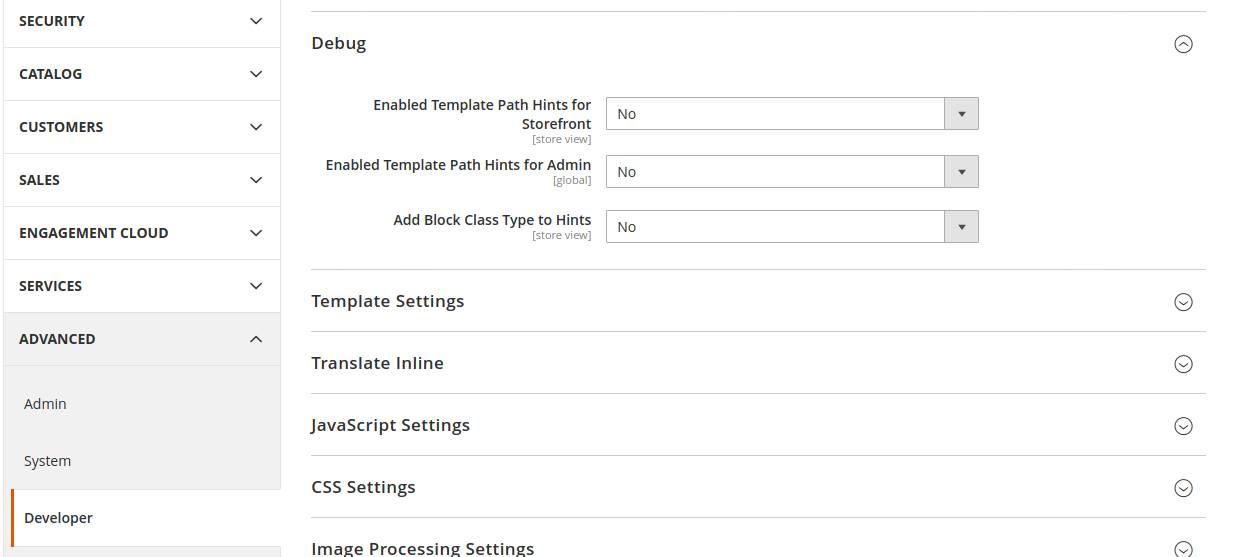
Source: Magento
Another way to speed up your Magento website is by using a Progressive Web Application (PWA). This technology makes user interactions more responsive and provides smoother animations and frictionless scrolling.
Mobile optimization in Magento
In addition to the above suggestions for site speed, the most influential way to ensure your Magento site performs well on mobile devices is to design it with mobile in mind. It is important to ensure you keep it as simple, clean, and straightforward as possible.
Large e-commerce stores can easily become complicated, so keeping the design somewhat minimalistic will help to make mobile navigation as seamless as possible. All buttons and elements must be big enough to tap without accidentally hitting something else, and all menus should be easy to navigate.
All of your content needs to be readable on smaller screens, too. This means having short paragraphs, large enough text, and videos that play well on small screens without weighing down the page. Everything in your store should be designed to look good and work well on phones and tablets.
Pay special attention to where your mobile users leave the store. If you find any sudden drops in engagement in your analytics platforms, these are a clear sign of huge performance and usability issues.
Many e-commerce stores struggle with ‘Cart’ and ‘Checkout’ performance, as these pages can unknowingly create significant problems for user engagement. Ensure your checkout process isn’t burdened with heavy JS files and complex third-party extensions and instead explore options such as One-Page Checkout.
Canonicalization and pagination strategies
By default, Magento 2 uses GET-parameters to show pagination in URLs. For example, if Oncrawl were to have a Magento store, it would look like oncrawl.com/category-name?p=2 or something similar, such as oncrawl.com/my-awesome-category?page=3. If needed, you can use some of the SEO extensions mentioned earlier in this article to extend this functionality and modify the pagination format to suit your needs.
Magento 2 also has several canonical settings available out of the box, allowing us to control how we want products and categories handled. Within the ‘Catalog’ and then the ‘Search Engine Optimization’ section, you should be able to edit the below options depending on your requirements:
If you want Google to index pages with complete category URL paths only:
- Use Canonical Link Meta Tag for Categories – “Yes”.
- Use Canonical Link Meta Tag for Products – “No”.
If you want Google to index the product pages only:
- Use Canonical Link Meta Tag for Categories – “No”.
- Use Canonical Link Meta Tag for Products – “Yes”.
If you want Google to index categories and products, enable both options:
- Use Canonical Link Meta Tag for Categories – “Yes”.
- Use Canonical Link Meta Tag for Products – “Yes”.
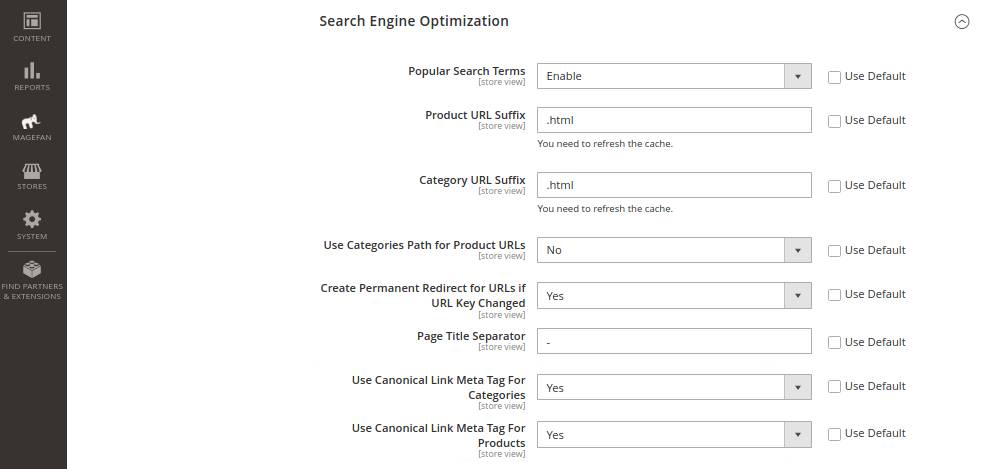
Source: Magento
Once done, make sure you save the changes and clear the cache. If needed, you can also use the rel=canonical <link> tag within the code to set more specific canonicals.
Adobe Commerce and Oncrawl
Oncrawl stands out as a powerful technical SEO crawler, uniquely capable of navigating complex e-commerce websites with ease.
The problem with large websites is that they can be difficult to interpret. This is where Oncrawl can help; their powerful segmentation feature allows us to create groups to help us view our technical SEO data in a meaningful way. This is helpful because when we look at the crawl results using segmentation, we can see trends and behaviors across the different sections of your website that may otherwise have been missed.
What I also like about Oncrawl is how it helps with site speed performance. Most e-commerce websites have some form of site speed issues, which can be even more challenging when there are multiple templates to analyze. The crawler provides information about:
- How many pages are too slow.
- Their average load time.
- Their weight distribution
- Their load time by page depth.
We can also click on each section to see the specific URLs that are affected.
Oncrawl’s ability to spot errors in our canonical strategy is a huge time-saver. The pie chart feature makes it crystal clear which URLs have a matching or not matching canonical or where a canonical has not been set. This allows us to quickly edit any necessary settings in Magento.
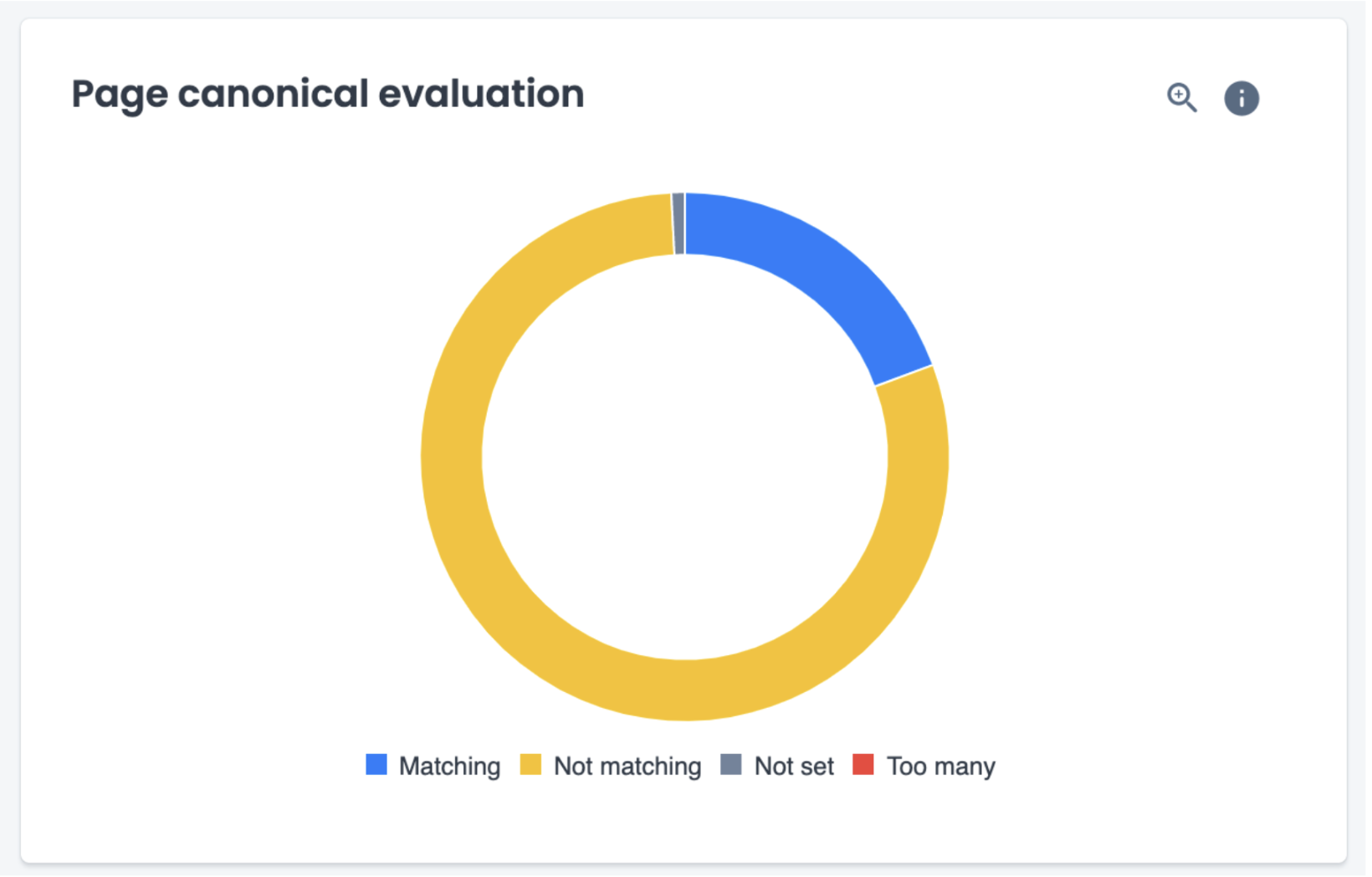
Source: Oncrawl
Mastering Magento optimizations for e-commerce
There’s no doubt that Magento is one of the most powerful, scalable, and robust platforms for building e-commerce sites. However, it can be complex, and you will need experienced developers and SEO support.
In my experience and through working with clients on many Magento stores, although the platform may seem daunting initially, almost all of the SEO issues I’ve encountered on Magento have been fixable.
By following the processes included in this article, as SEOs, we are adding more and more skills to our toolset, making us indispensable for business owners and agencies.

